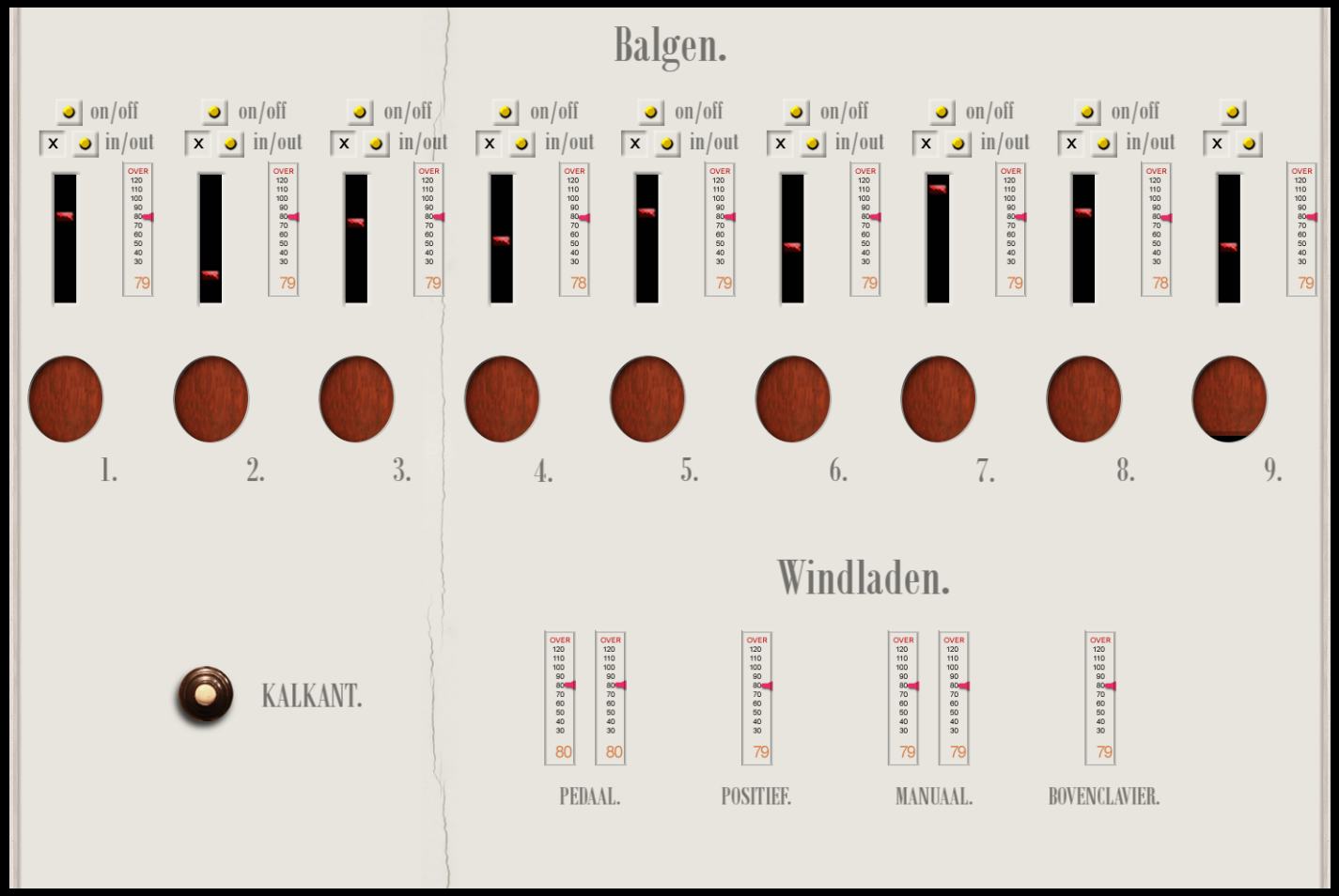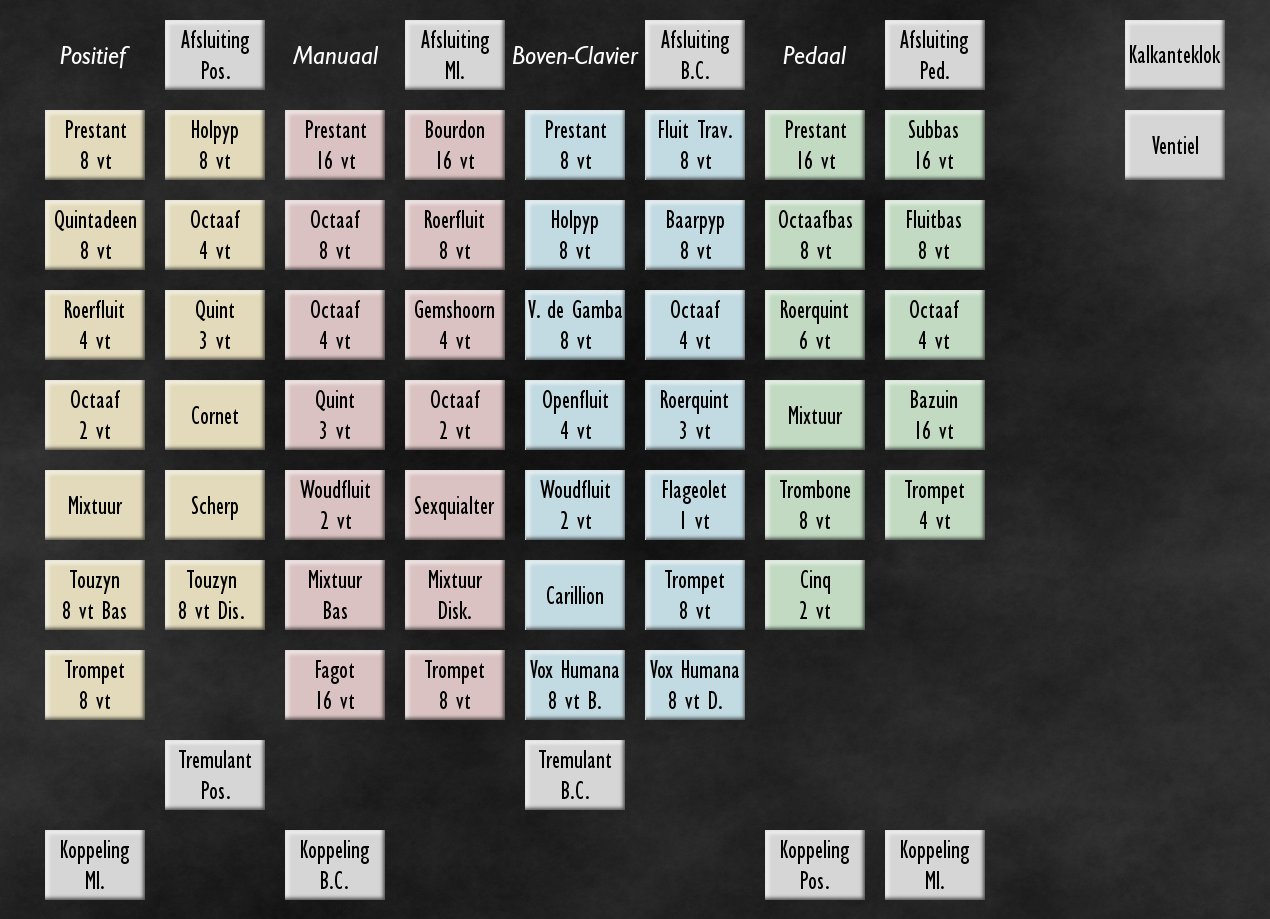Sonus Paradisi
Utrecht, 1831 [Hauptwerk]
Utrecht, 1831 [Hauptwerk]
Couldn't load pickup availability
The organ of the Domkerk Utrecht, Netherlands
The present instrument incorporates parts of an earlier organ, namely the 1569 - 1571 Peter Janszoon de Swart renaissance organ. From this famous and capable organ builder 6 stops in the Rugwerk, 3 in the Bovenwerk, and 2 in the Pedal still remain in the instrument.
The Bätz organ company, one of the leading organ builders in the Netherlands during the 18th and 19th century, built a totally new instrument as we see it today in its present form, while using several old stops, as indicated above. Nevertheless the company created an instrument in the style of the early 19th century.
The organ is widely acclaimed for its mild tone and its expressive tremulants which make the instrument really suitable for the romantic style of compositions, especially the Dutch romantic (and post-romantic) music. This time, recording the tremmed ranks was indispensable to preserve the special character of the instrument. Most of the ranks of the Ist and IIIrd manuals are, therefore, included also with the recorded tremmed ranks.
The church building is really generous in space. It is however only a fraction of its original size, the great nave was destroyed in the past, so that only the Choir plus the Transept remains. The organ is positioned centrally in the back wall of the Transept. Perhaps because of this, the sound is rather diffused. This sample set is therefore really very "wet", unlike other sample sets from the Sonus Paradisi collection.
Presented to you by Leonart Studio, your authorised reseller for Sonus Paradisi in Switzerland (shipped internationally). Get your digitally sampled historical organs for the use with the Hauptwerk virtual instrument software.
Share this Sample Set
![Utrecht, 1831 [Hauptwerk]](http://artful.shop/cdn/shop/files/ss_utrecht1.jpg?v=1693295576&width=1445)
![Utrecht, 1831 [Hauptwerk]](http://artful.shop/cdn/shop/files/ss_utrecht2.jpg?v=1693295577&width=1445)
![Utrecht, 1831 [Hauptwerk]](http://artful.shop/cdn/shop/files/ss_utrecht3.jpg?v=1693295577&width=1445)
![Utrecht, 1831 [Hauptwerk]](http://artful.shop/cdn/shop/files/ss_utrecht4.jpg?v=1693295577&width=1445)
![Utrecht, 1831 [Hauptwerk]](http://artful.shop/cdn/shop/files/ss_utrecht11.jpg?v=1693295576&width=1445)
Specification (stop list)
-
Manual I
Rugwerk
Prestant 8'
Holpijp 8'
Quintadeen 8'
Octaaf 4'
Roerfluit 4'
Quint 3'
Octaaf 2'
Fluit 2'
Mixtuur 3-6st.
Scherp 3-4st.
Cornet desc. 5st.
Trompet 8'
Touzyn bass/desc. 8'
Tremulant -
Manual II
Hoofdwerk
Prestant 16'
Bourdon 16'
Octaaf 8'
Roerfluit 8'
Octaaf 4'
Gemshoorn 4'
Quint 3'
Octaaf 2'
Woudfluit 2'
Mixtuur bass/desc. 4-8st .
Sexquialter desc. 4st.
Fagot 16'
Trompet 8' -
Manual III
Bovenwerk
Prestant 8'
Baarpijp 8'
Holpijp 8'
Viola de Gamba 8'
Fluittravers 8'
Octaaf 4'
Open fluit 4'
Roerquint 3'
Woudfluit 2'
Flageolet 1'
Carillon 3st.
Trompet 8'
Voxhumana bass/desc. 8'
Tremulant -
Manual IV
-
-
Pedal
Prestant 16'
Subbas 16'
Octaafbas 8'
Fluitbas 8'
Roerquint 6'
Octaaf 4'
Mixtuur 4 st.
Bazuin 16'
Trombone 8'
Trompet 4'
Cinq 2' -
Other specification
couplers: Hw/Rw, Bw/Hw, Hw/P, Rw/P
Manuals C-f3, pedal C-d1 (extended in the virtual version up to an f1)
All pipes from 1831, except:
Rw: Quintadeen 8', Octaaf 4' , Quint 3', Octaaf 2', Mixtuur and Scherp = mostly from 1571,
Roerfluit 4' = from 1700,
Fluit 2' and Touzyn 8' = from1974.
Hw: Sexquialter, Gemshoorn 4', Woudfluit 2' and Trompet 8' = from1974.
Bw: Open fluit 4', Gemshoorn 2' (labelled Woudfluit nowadays) and Flageolet 1' mostly from 1571,
Roerquint 3' and Voxhumana 8' = from 1974
P: Octaaf 4' 1571, Roerquint 6' from 1700.
The drawstop called "Ventiel" is a device to empty the bellows. If drawn out, the hole to the main wind trunk is opened and the air easily escapes from bellows.
History
The organ of the Domkerk Utrecht, Netherlands
The present instrument incorporates parts of an earlier organ, namely the 1569 - 1571 Peter Janszoon de Swart renaissance organ. From this famous and capable organ builder 6 stops in de Rugwerk, 3 in the Bovenwerk, and 2 in the Pedal still remain in the instrument. Notably the plenum formed by octaaf 4 and 2', the quint 3' and the two mixtures in the Rugwerk are from de Swart. In manufacture as well as in sound quality these pipes are the best of the organ. Due to the usual compass of instruments in the 16th century the old pipes are basically in the region F, G, A - f#2, a2, the remainder made new in1640, 1709 and 1831.
The Bätz organ company, one of the leading organ builders in the Netherlands during the 18th and 19th century, built a totally new instrument as we see it today in its present form, while using several old stops, as indicated above. Nevertheless the company created an organ in the style of the early 19th century, while the architect of the church, Tieleman Franciscus Suys from Brussel, Belgium designed the case and ornaments as well as the new chamber for the 9 wedge bellows. The case is neo-classic, with gothic elements for the ornaments.
The organ itself is built in such a way that all parts such as pipes and mechanism can easily be reached. The famous French organ builder Cavaillé-Coll expressed his admiration for the spacious layout during a visit in november 1844.
In 1865 the successor of Bätz, C.G.F. Witte exchanged the sexquialter of the Hoofdwerk for a Cornet 5 ranks and in 1895 this company revoiced all the reed stops. During the period between 1911 and 1936 the Tousijn 8' en Fluit 2' on the Rugwerk were removed, there was a renewal of the HW Trompet 8'. The Gemshoorn 4' and Woudfluit 2' were also removed and a swell box for the Bovenwerk was added. On the Bovenwerk the Roerquint 3' and Vox Humana 8' were exchanged for romantic stops, and finally in 1935 the bellows chamber was demolished and in the relatively shallow organ case a new wind supply was improvised.
During the 1972-73 extensive restoration by Van Vulpen, the experts in maintenance and restoring Bätz organs, the stops removed earlier were reconstructed. A new wind supply system with six regulators was built within the main case, because there was no place left outside the organ for a system based on wedge bellows. The swell box was kept as a useful addition.
[The information about the orgen compiled by Ir. Hendrik Kooiker E.I.]
Sample set producer's remarks
The organ is widely acclaimed for its mild tone and its expressive tremulants which make the instrument really suitable for the romantic style of compositions, especially the Dutch romantic (and post-romantic) music. This time, recording the tremmed ranks was indispensable to preserve the special character of the instrument. Most of the ranks of the Ist and IIIrd manuals are, therefore, included also with the recorded tremmed ranks.
The church building is really generous in space. It is however only a fraction of its original size, the great nave was destroyed in the past, so that only the Choir plus the Transept remains. The organ is positioned centrally in the back wall of the Transept. Perhaps because of this, the sound is rather diffused. This sample set is therefore really very "wet", unlike other sample sets from the Sonus Paradisi collection.
Features
The current version of the sample set is 2.7 (26th June, 2021). This virtual organ model requires Hauptwerk ver. 4 and above.
New in version 2.7
Mixer tab added with the usual perspective sliders, including pipe coupling and pipe detuning features. Fine Tuned Mixtures switch.
The Compass
The original compass of the manuals is 54 keys. The compass was extended virtually to 56 keys. The pedal compass is 27 tones. The pedal compass was virtually extended up to the 30 tones.
Sample Quality
The samples are offered in 24bit/48kHz quality, multiple releases (3 levels). Plain wave formant (no encryption). The reverberation time is up to 6 seconds for the ambiental version. The sample set is offered in surround (four channels). Many ranks of Positiv and Bovenwerk offer recorded tremmed samples (recorded tremulants).




Requirements
Surround:
The surround recording uses 4 independent channels for each virtual pipe (for each sample). The sound of the organ pipes is captured by the front microphones, the church response by the rear microphones. The 4 channels are extracted from the recording and assembled to the sample set. The two front channels are used to supply the sound of the organ to the front speakers, while the 2 other channels offer the response of the church. You can use these two channels to feed your surround (rear) speakers. Please note, that at least 4 speakers are needed to reproduce the multi-channel audio.
RAM requirements (full surround, L/R split rank components loaded in mono, memory compression enabled):
*** please refer to the blog post for help achieving these RAM consumption figures ***
16-bit: 17,0 GB
20-bit: 29,8 GB
24-bit: 32,6 GB
To get less reverberant variant of the sample set, two users independently suggested this alternative setup:
truncate the reverb of the front samples at 3,5 seconds
reduce volume of the rear channels (-3 dB or so)
Wet:
For use in headphones or other 2-channels environment: please disable all the ranks marked by the word "rear" in the rank audio output dialog when loading the organ for the first time. By doing this, the rear ranks will be muted and only the two front channels will load. The RAM consumption is reduced to half.
RAM requirements (wet only):
16-bit: cca. 9.6 GB
20-bit: cca 16.7 GB
24-bit: cca. 18.2 GB
For use on 16 GB RAM machines, you may experiement with loading most of the sample set in 24 bit depth, but setting some ranks to 20 or 16 bit to save some RAM. Pedal ranks can usually safely be loaded in 16-bits. Nevertheless, 20-bit depth is recommended as the quality of audio in 20-bit is very good and mostly undistinguishable from 24-bit.
See the screenshot for an illustration how to identify the rear ranks (there are two kinds - a normal rear rank and a tremmed rear rank), all of these may be selected and muted (by clicking on the box near to the "Rank enabled?" question and selecting "No".
This Hauptwerk Sample Set is presented to you by Leonart Studio, an authorised reseller for the manufacturer Sonus Paradisi in Switzerland (shipping internationally). Enjoy this digitally sampled organ library for the use with Hauptwerk software and start expanding your historical organ collection today.
More Hauptwerk Sample Sets
-
Casavant, 1995 [Hauptwerk]
Vendor:Sonus ParadisiRegular price CHF 174.90Regular priceUnit price / per -
Bückeburg, 1997 [Hauptwerk]
Vendor:Sonus ParadisiRegular price From CHF 1.10Regular priceUnit price / per -
Schwerin, Dom, Ladegast Organ 1871 [Hauptwerk]
Vendor:Sonus ParadisiRegular price CHF 616.00Regular priceUnit price / per -
Segovia, 1772 [Hauptwerk]
Vendor:Sonus ParadisiRegular price CHF 317.90Regular priceUnit price / per -
Reuter, 1928 [Hauptwerk]
Vendor:Sonus ParadisiRegular price CHF 473.00Regular priceUnit price / per -
Rotterdam Hoofdorgel, 1973 [Hauptwerk]
Vendor:Sonus ParadisiRegular price From CHF 330.00Regular priceUnit price / perCHF 958.10Sale price From CHF 330.00Sale -
Groningen, 1450-1740 [Hauptwerk]
Vendor:Sonus ParadisiRegular price From CHF 658.90Regular priceUnit price / perCHF 1,681.90Sale price From CHF 658.90Sale -
Frankfurt a.d. Oder, 1975 [Hauptwerk]
Vendor:Sonus ParadisiRegular price From CHF 220.00Regular priceUnit price / perCHF 550.00Sale price From CHF 220.00Sale -
Piacenza, 1838 [Hauptwerk]
Vendor:Sonus ParadisiRegular price CHF 330.00Regular priceUnit price / per -
Lüdingworth, 1683 [Hauptwerk]
Vendor:Sonus ParadisiRegular price CHF 330.00Regular priceUnit price / per






![Casavant, 1995 [Hauptwerk]](http://artful.shop/cdn/shop/files/ss_casavant1.jpg?v=1693319885&width=533)
![Bückeburg, 1997 [Hauptwerk]](http://artful.shop/cdn/shop/files/ss_bueckeburg1.jpg?v=1692967628&width=533)
![Schwerin, Dom, Ladegast Organ 1871 [Hauptwerk]](http://artful.shop/cdn/shop/files/ladegast1.jpg?v=1759140126&width=533)
![Segovia, 1772 [Hauptwerk]](http://artful.shop/cdn/shop/files/ss_segovia1.jpg?v=1714213906&width=533)
![Reuter, 1928 [Hauptwerk]](http://artful.shop/cdn/shop/files/ss_Reuter1.jpg?v=1693321024&width=533)
![Rotterdam Hoofdorgel, 1973 [Hauptwerk]](http://artful.shop/cdn/shop/files/ss_RotterdamMain1.jpg?v=1693279529&width=533)
![Groningen, 1450-1740 [Hauptwerk]](http://artful.shop/cdn/shop/files/ss_Groningen1.jpg?v=1693275425&width=533)
![Frankfurt a.d. Oder, 1975 [Hauptwerk]](http://artful.shop/cdn/shop/files/ss_frankfurtoder1.jpg?v=1692974219&width=533)
![Piacenza, 1838 [Hauptwerk]](http://artful.shop/cdn/shop/files/ss_piacenza1.jpg?v=1693003521&width=533)
![Lüdingworth, 1683 [Hauptwerk]](http://artful.shop/cdn/shop/files/ss_luedingworth1.jpg?v=1692998051&width=533)